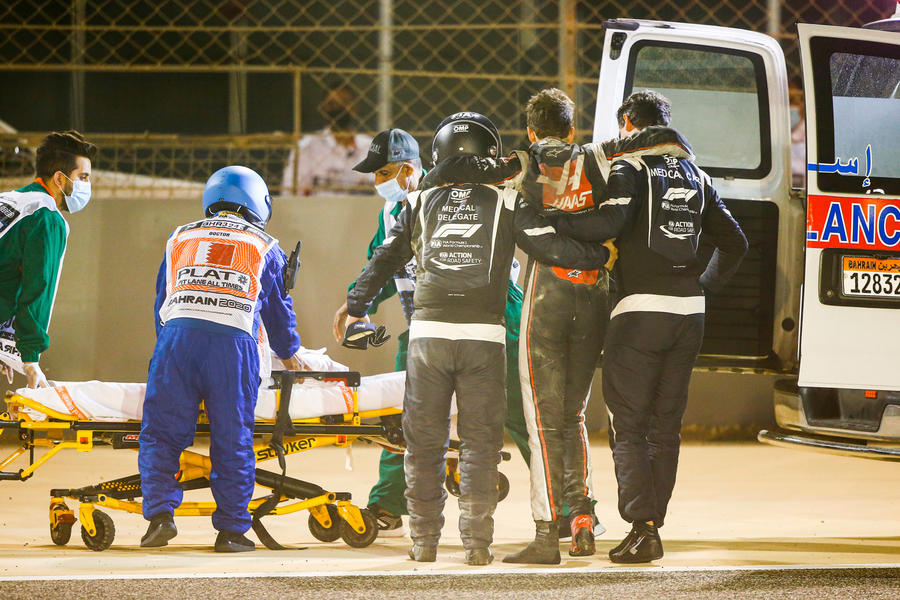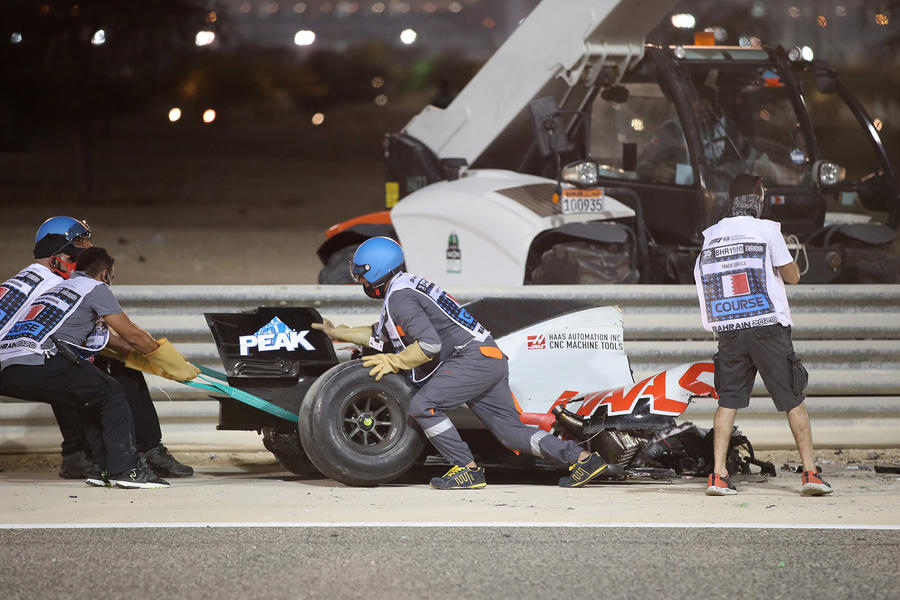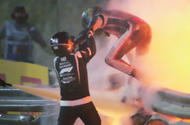Grosjean incredibly extricated himself from the inferno
Romain Grosjean’s crash was terrifying, but it should also be reassuring for Formula 1
Motor racing is the best it has ever been right now. Just ask Romain Grosjean, or his wife and three young children for that matter. “I wasn’t for the halo some years ago,” said the Frenchman from his hospital bed following the Bahrain Grand Prix. “But I think it’s the greatest thing we’ve brought to F1, and without it I wouldn’t be able to speak to you today.”
Like Grosjean, I was no fan of this ugly, heavy safety bar when it became mandatory over F1 cockpits in 2018. And also like Grosjean, I’m happy to admit when I’m wrong – in this case utterly so. At Sakhir, it proved a life-saver, not for the first and surely not for the last time.
Modern motorsport has its flaws, faces incontrovertible challenges that threaten its future and in the eyes of too many is diminished from what it used to be. But when it comes to safety – the only aspect that really matters when you get to the nub – the sport today is far superior to any time in its chequered history. Not everything was better back then.
A reminder of F1’s grim past
Grosjean’s survival was a miraculous double deliverance: first, from the monstrous, 53g impact with a naked steel barrier; second, from the fiery explosion that engulfed him. The crash represented something new and unseen for the likes of FIA medical car crew Alan van der Merwe and Dr Ian Roberts, who both deserve every ounce of praise for their rapid, selfless actions in the all too literal heat of the moment. But it wasn’t something new; rather it was a stark reminder of F1’s grim past, when such scenes were far from the exception.

How Grosjean’s Haas split the barrier, its front half ending up embedded within it, had strong echoes of the accident that claimed the life of Jackie Stewart’s dear friend and Tyrrell team-mate François Cevert at Watkins Glen in 1973. Poor Cevert had nothing to protect his head and torso from a gruesome fate all those years ago.
Likewise, the flames triggered recollections of Roger Williamson’s burning March at Zandvoort, also in 1973, back when fire was the racing driver’s greatest enemy. Unlike at Sakhir, the marshals were grossly illequipped to tackle the blaze, leaving David Purley, who pulled over and jumped from his car, to single-handedly strive to free his colleague from the inverted wreck.
Purley’s disgusted desolation when he realised that his heroic efforts were in vain shocked the world back then – but not enough to fully awaken motor racing from its laissez-faire slumber. Where once there was a shrugging acceptance that motor racing was a mortally perilous activity undertaken at one’s own risk, today there’s a welcome intolerance to such negligence. Investigations into every aspect of Grosjean’s crash will be both swift and thorough, lessons will be learned and positive action will be taken. It’s impossible to legislate accidents out of existence, of course, and racing will always remain dangerous. But there’s a reason why life-changing injury and death have become the exception rather than the rule.
What could change?
The car itself withstood the impact remarkably well. Yes, the rear end was torn off, the triple Zylon tethers failed to restrain the front wheels and clearly any proven fuel cell rupture (super-rare these days) would be of serious concern. But given the extreme violence of the impact, the most important bit – the safety cell that cocoons the driver – did exactly what it was supposed to. The halo didn’t even impede Grosjean’s escape, even if it was pure dumb luck that the chassis embedded in a manner that allowed him a clear route to freedom. But perhaps the biggest concern was the barrier itself.
Multi-layered steel became the go-to solution for race tracks half a century ago, when such barriers replaced the Nürburgring’s ditches and trees as the boundary between circuit and forest. But even then they were controversial and are long outdated. It’s only a surprise they remain in use, if only on the bits of track that racing drivers don’t usually hit. Grosjean’s crash, which occurred at a point of hard acceleration exiting a corner, highlights that crashes can and will happen anywhere and at any time. Perhaps this will finally mark the beginning of the end for the old unforgiving rings of steel.

A much more worrying failure
Grosjean’s crash captured the attention, but I’d argue that the most concerning breach of safety in Bahrain had nothing at all to do with that incident. Instead, it occurred three laps from the end when Sergio Pérez pulled over on a straight to retire his broken Racing Point. As Lando Norris accelerated towards the scene, he was alarmed to spot a marshal running across the track in front of him. Freak accidents are one thing, but it’s unforgivable that such an action, well intentioned as it was, should be allowed to occur at a race track in 2020.
Again, this has ancient, grim precedence. At the 1977 South African Grand Prix, a marshal carrying a fire extinguisher crossed the track at Kyalami to attend to Renzo Zorzi’s stricken car – only to be collected by the unsighted Tom Pryce, who was on full power in his Shadow. Both the talented Welshman and the poor marshal died instantly in an accident of unspeakable violence. The tragedy shouldn’t have happened then and absolutely mustn’t be repeated now. F1 must act hard and fast on this one, not to punish the individual but to ensure that nobody working at a track anywhere can put themselves or anyone else at such unnecessary risk.
F1’s old history of violence is outside living memory for the majority involved today. But Bahrain reminded us that it should never be forgotten. Racing tragedy is and never can be extinct: at best it’s dormant. Constant vigilance is the only answer.
READ MORE
Racing lines: Alonso down but not done with Indianapolis
Source: Autocar
